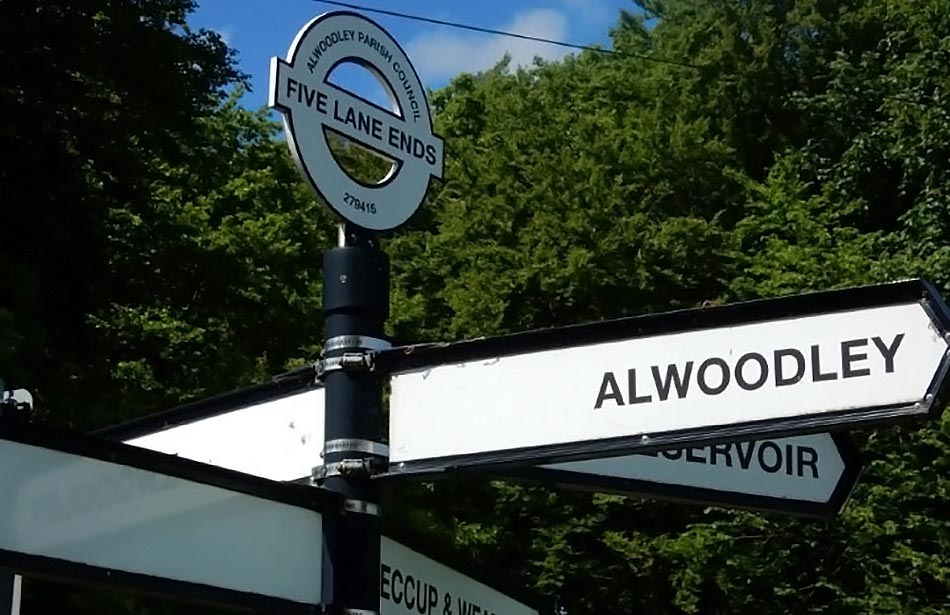Alwoodley History
The civil parish of Alwoodley was formed in 2008 and consists of most of Alwoodley and the village of Eccup as well as farm land.
Alwoodley, the name.
The name Alwoodley is said to be of Saxon origin and is possibly a corruption of Aethelwaldley, meaning either a clearing in the alderwood or at Aethelwald’s farm. Alwoodley is in the Norman Domesday Book of 1086. It shows the area was farmed in the late eleventh century by a man named Rosketill.
The name Alwoodley is thought to derive from Old English Æthelwald-lēah, meaning The woodland clearing (lēah), at Æthelwald’s farm
Anon.
Also in the Domesday book is Eccup which was owned by the Count of Mortain and Richard de Surdeval. Adel Mill, which is also in the modern parish, is a historic settlement which as long ago as 1200 was the subject of a legal dispute between the Abbot of Kirkstall and the Prior of Holy Trinity Priory, York.
From the Middle Ages until the end of the nineteenth century Alwoodley was a collection of farms, with heath, marsh and woodland, although there was one large house, Alwoodley Old Hall, which was constructed In the late medieval period. It was the seat of the Frank family until 1638. The hall was on land leased to Sand Moor Golf Club but was demolished in 1969.
In the 1840s the Leeds Waterworks Company acquired land from the Earl of Harewood for Eccup Reservoir to provide the City of Leeds with clean drinking water. The reservoir was expanded in the 1850s and again in the 1890s. It now has a water treatment works.

Four brick shafts were constructed in Alwoodley to serve the tunnel which brought the water from Eccup Reservoir over the Seven Arches aqueduct in Adel Woods into Leeds.
Incorporation into Leeds
Until the 1920s Alwoodley and Eccup were part of the Wharfedale Rural District Council under the West Riding of Yorkshire County Council. Under an Act of Parliament in 1927, Alwoodley was incorporated into Leeds and Eccup was incorporated into the city two years later.
Many Alwoodley residents had originally been opposed to incorporation into Leeds. However, they were persuaded to agree to it when the City of Leeds offered Alwoodley ratepayers a preferential rate for 15 years. Incorporation provided Alwoodley with modern utilities and services, such as water, gas, electricity, street lighting, sewerage and improved roads.
A rural escape
From the late nineteenth century Alwoodley provided a rural retreat for residents of the expanding industrial city. Adel Crags and the Seven Arches Aqueduct were popular attractions in the area and Verity’s Tea Rooms in Adel Woods and Carrie’s Café on The Avenue provided refreshments to these tourists from the city.


In the 1930s, several people built their own holiday homes on land in Alwoodley. The constructions were considered insanitary by the City Council and most were removed after the Second World War.
Housing Development
The development of private suburban housing began in Alwoodley in the interwar years. A brochure for the Alwoodley Park Estate published in 1929 emphasised the natural attractions of the local area and promised modern houses in a healthy setting.
The development incorporated semi-detached houses, bungalows and detached ‘villas.’ and by 1938, much of the western portion of Alwoodley Park had been built and the western end of Alwoodley Lane had been developed. The Primley Park estate was built in this decade.
Although a bus route served Alwoodley from the 1930s, the suburb was mainly designed for the private car, which enabled residents to access what was then a relatively remote area. Unlike other interwar suburbs, it lacked a rail link or a tram line. Several roads were improved in the 1930s including Alwoodley Lane, King Lane and Nursery Lane.
1929-1938
Development of private housing began
1950-1970
Rapid new house building development
1990s
Last small development (Windermere Drive)
The 1950s and 1960s saw rapid house building development. The Avenue was completed. Housing was built on the Mounts, the Buckstones and the Meadows. Housing was also constructed along the Fairway and Alwoodley Lane.
The last major housing development in Alwoodley on a green field site was built in the late 1970s when Moor Allerton Golf Club moved to Scarcroft and sold its former site which was developed using the names of famous golf courses (Gleneagles, Wentworth, Turnberry and Sunningdale) for the street names. There was one small encroachment into open countryside in the 1990s when Windermere Drive off Alwoodley Lane was built.
